github : https://github.com/twomeng/logistic-regression-
ex1. m
1 %% Machine Learning Online Class - Exercise 2: Logistic Regression 2 % 3 % Instructions 4 % ------------ 5 % 6 % This file contains code that helps you get started on the logistic 7 % regression exercise. You will need to complete the following functions 8 % in this exericse: 9 % 10 % sigmoid.m 11 % costFunction.m 12 % predict.m 13 % costFunctionReg.m 14 % 15 % For this exercise, you will not need to change any code in this file, 16 % or any other files other than those mentioned above. 17 % 18 19 %% Initialization 20 clear ; close all; clc 21 22 %% Load Data 23 % The first two columns contains the exam scores and the third column 24 % contains the label. 25 26 data = load('ex2data1.txt'); 27 X = data(:, [1, 2]); y = data(:, 3); 28 29 %% ==================== Part 1: Plotting ==================== 30 % We start the exercise by first plotting the data to understand the 31 % the problem we are working with. 32 33 fprintf(['Plotting data with + indicating (y = 1) examples and o ' ... 34 'indicating (y = 0) examples.\n']); 35 36 plotData(X, y); 37 38 % Put some labels 39 hold on; 40 % Labels and Legend 41 xlabel('Exam 1 score') 42 ylabel('Exam 2 score') 43 44 % Specified in plot order 45 legend('Admitted', 'Not admitted') 46 hold off; 47 48 fprintf('\nProgram paused. Press enter to continue.\n'); 49 pause; 50 51 52 %% ============ Part 2: Compute Cost and Gradient ============ 53 % In this part of the exercise, you will implement the cost and gradient 54 % for logistic regression. You neeed to complete the code in 55 % costFunction.m 56 57 % Setup the data matrix appropriately, and add ones for the intercept term 58 [m, n] = size(X); 59 60 % Add intercept term to x and X_test 61 X = [ones(m, 1) X]; 62 63 % Initialize fitting parameters 64 initial_theta = zeros(n + 1, 1); 65 66 % Compute and display initial cost and gradient 67 [cost, grad] = costFunction(initial_theta, X, y); 68 69 fprintf('Cost at initial theta (zeros): %f\n', cost); 70 fprintf('Expected cost (approx): 0.693\n'); 71 fprintf('Gradient at initial theta (zeros): \n'); 72 fprintf(' %f \n', grad); 73 fprintf('Expected gradients (approx):\n -0.1000\n -12.0092\n -11.2628\n'); 74 75 % Compute and display cost and gradient with non-zero theta 76 test_theta = [-24; 0.2; 0.2]; 77 [cost, grad] = costFunction(test_theta, X, y); 78 79 fprintf('\nCost at test theta: %f\n', cost); 80 fprintf('Expected cost (approx): 0.218\n'); 81 fprintf('Gradient at test theta: \n'); 82 fprintf(' %f \n', grad); 83 fprintf('Expected gradients (approx):\n 0.043\n 2.566\n 2.647\n'); 84 85 fprintf('\nProgram paused. Press enter to continue.\n'); 86 pause; 87 88 89 %% ============= Part 3: Optimizing using fminunc ============= 90 % In this exercise, you will use a built-in function (fminunc) to find the 91 % optimal parameters theta. 92 93 % Set options for fminunc 94 options = optimset('GradObj', 'on', 'MaxIter', 400); 95 96 % Run fminunc to obtain the optimal theta 97 % This function will return theta and the cost 98 [theta, cost] = ... 99 fminunc(@(t)(costFunction(t, X, y)), initial_theta, options); 100 101 % Print theta to screen 102 fprintf('Cost at theta found by fminunc: %f\n', cost); 103 fprintf('Expected cost (approx): 0.203\n'); 104 fprintf('theta: \n'); 105 fprintf(' %f \n', theta); 106 fprintf('Expected theta (approx):\n'); 107 fprintf(' -25.161\n 0.206\n 0.201\n'); 108 109 % Plot Boundary 110 plotDecisionBoundary(theta, X, y); 111 112 % Put some labels 113 hold on; 114 % Labels and Legend 115 xlabel('Exam 1 score') 116 ylabel('Exam 2 score') 117 118 % Specified in plot order 119 legend('Admitted', 'Not admitted') 120 hold off; 121 122 fprintf('\nProgram paused. Press enter to continue.\n'); 123 pause; 124 125 %% ============== Part 4: Predict and Accuracies ============== 126 % After learning the parameters, you'll like to use it to predict the outcomes 127 % on unseen data. In this part, you will use the logistic regression model 128 % to predict the probability that a student with score 45 on exam 1 and 129 % score 85 on exam 2 will be admitted. 130 % 131 % Furthermore, you will compute the training and test set accuracies of 132 % our model. 133 % 134 % Your task is to complete the code in predict.m 135 136 % Predict probability for a student with score 45 on exam 1 137 % and score 85 on exam 2 138 139 prob = sigmoid([1 45 85] * theta); 140 fprintf(['For a student with scores 45 and 85, we predict an admission ' ... 141 'probability of %f\n'], prob); 142 fprintf('Expected value: 0.775 +/- 0.002\n\n'); 143 144 % Compute accuracy on our training set 145 p = predict(theta, X); 146 147 fprintf('Train Accuracy: %f\n', mean(double(p == y)) * 100); 148 fprintf('Expected accuracy (approx): 89.0\n'); 149 fprintf('\n');
plotData. m
1 function plotData(X, y) 2 %PLOTDATA Plots the data points X and y into a new figure 3 % PLOTDATA(x,y) plots the data points with + for the positive examples 4 % and o for the negative examples. X is assumed to be a Mx2 matrix. 5 6 % Create New Figure 7 figure; hold on; 8 9 % ====================== YOUR CODE HERE ====================== 10 % Instructions: Plot the positive and negative examples on a 11 % 2D plot, using the option 'k+' for the positive 12 % examples and 'ko' for the negative examples. 13 % 14 15 pos = find(y==1); % find() return the position of y == 1 16 neg = find(y==0); 17 18 plot(X(pos,1),X(pos,2),'k+','LineWidth',2,'MarkerSize',7); 19 plot(X(neg,1),X(neg,2),'ko','LineWidth',2,'MarkerFaceColor','y','MarkerSize',7); 20 21 22 23 24 25 26 27 % ========================================================================= 28 29 30 31 hold off; 32 33 end
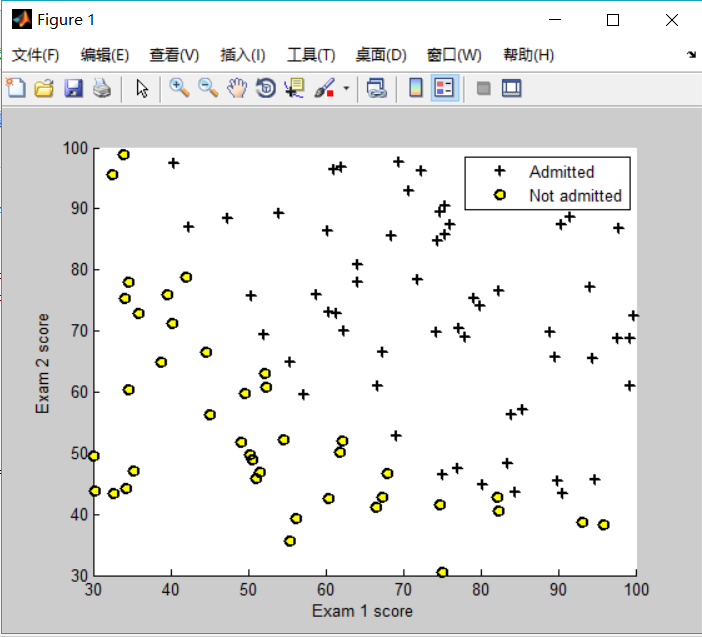
costFuction.m
1 function [J, grad] = costFunction(theta, X, y) 2 %COSTFUNCTION Compute cost and gradient for logistic regression 3 % J = COSTFUNCTION(theta, X, y) computes the cost of using theta as the 4 % parameter for logistic regression and the gradient of the cost 5 % w.r.t. to the parameters. 6 7 % Initialize some useful values 8 m = length(y); % number of training examples 9 10 % You need to return the following variables correctly 11 J = 0; 12 grad = zeros(size(theta)); 13 14 % ====================== YOUR CODE HERE ====================== 15 % Instructions: Compute the cost of a particular choice of theta. 16 % You should set J to the cost. 17 % Compute the partial derivatives and set grad to the partial 18 % derivatives of the cost w.r.t. each parameter in theta 19 % 20 % Note: grad should have the same dimensions as theta 21 % 22 alpha = 1 ; 23 J = (-1/m) * ( y' * log(sigmoid(X * theta)) + ( 1-y )'* log(1-sigmoid(X*theta))); 24 grad = ( alpha / m ) * X'* (sigmoid( X * theta ) - y); 25 26 27 28 29 30 31 % ============================================================= 32 33 end
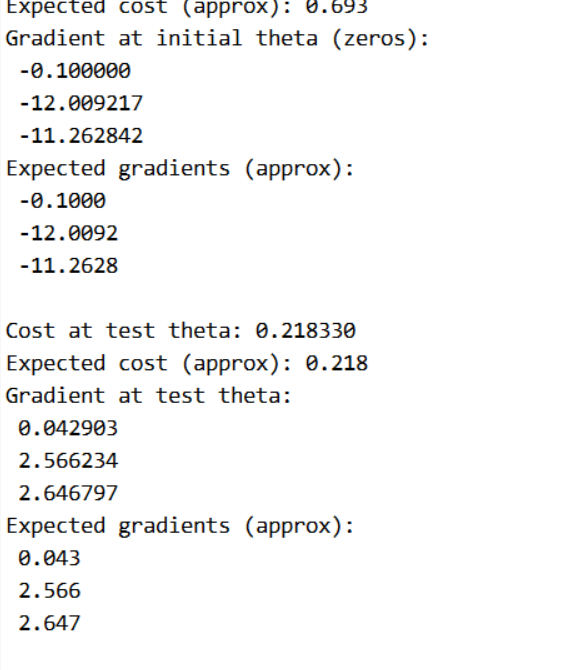
内置函数fminuc()
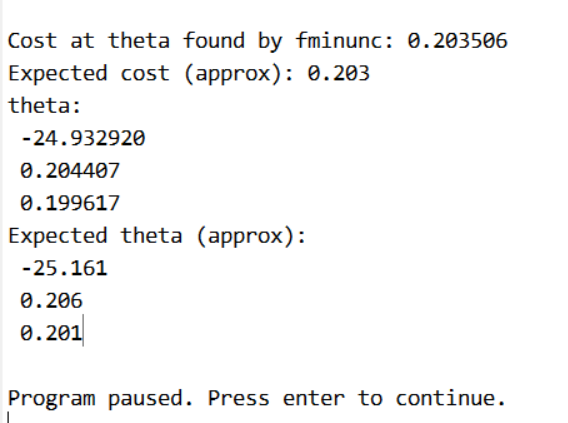
绘制边界函数:
if size(X, 2) <= 3 % Only need 2 points to define a line, so choose two endpoints 选择在坐标轴上的两个临界点 plot_x = [min(X(:,2))-2, max(X(:,2))+2]; % Calculate the decision boundary line theta(1) + theta(2) * x(1) + theta(3) * x(2) = 0 计算两个y在边界上的值 plot_y = (-1./theta(3)).*(theta(2).*plot_x + theta(1)); % Plot, and adjust axes for better viewing 两点确定一条直线 plot(plot_x, plot_y) % Legend, specific for the exercise legend('Admitted', 'Not admitted', 'Decision Boundary') axis([30, 100, 30, 100])
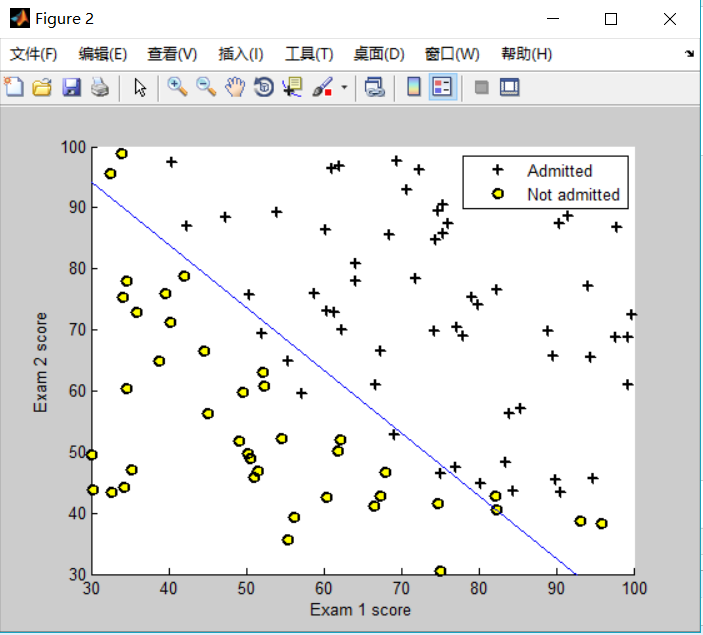
predict. m
1 function p = predict(theta, X) 2 %PREDICT Predict whether the label is 0 or 1 using learned logistic 3 %regression parameters theta 4 % p = PREDICT(theta, X) computes the predictions for X using a 5 % threshold at 0.5 (i.e., if sigmoid(theta'*x) >= 0.5, predict 1) 6 7 m = size(X, 1); % Number of training examples 8 9 % You need to return the following variables correctly 10 p = zeros(m, 1); 11 12 % ====================== YOUR CODE HERE ====================== 13 % Instructions: Complete the following code to make predictions using 14 % your learned logistic regression parameters. 15 % You should set p to a vector of 0's and 1's 16 % 17 18 % cal h(x) -- predictions 19 % pos = find(sigmoid( X * theta ) >= 0.5 ); 20 % neg = find(sigmoid( x * theta ) < 0.5 ); 21 p = sigmoid( X * theta ); 22 for i = 1:m 23 if p(i) >= 0.5 24 p(i) = 1; 25 else 26 p(i) = 0; 27 end 28 end 29 % ========================================================================= 30 end
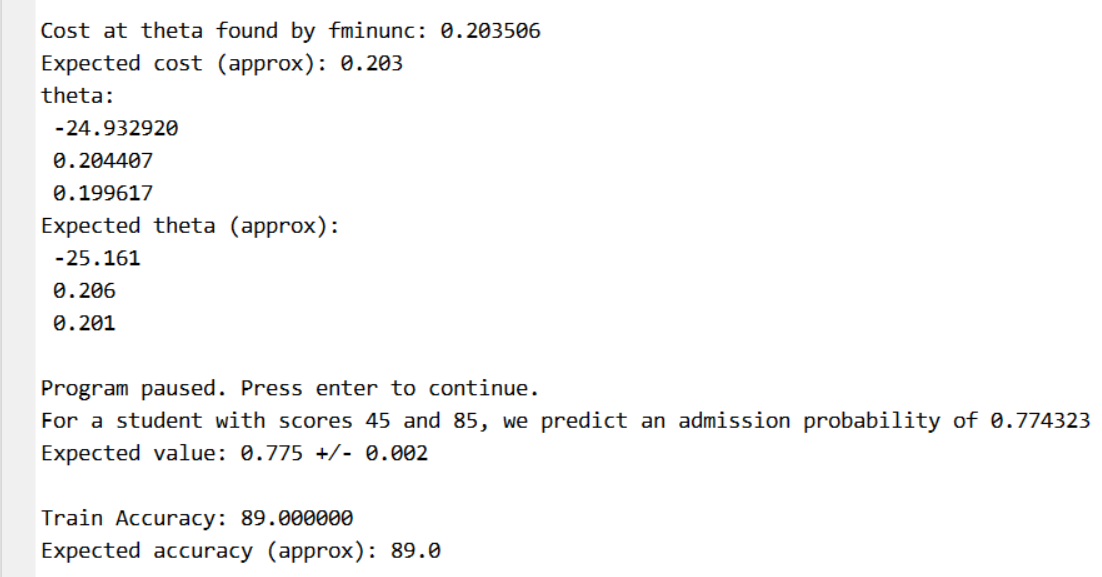
ex2_reg. m
1 %% Machine Learning Online Class - Exercise 2: Logistic Regression 2 % 3 % Instructions 4 % ------------ 5 % 6 % This file contains code that helps you get started on the second part 7 % of the exercise which covers regularization with logistic regression. 8 % 9 % You will need to complete the following functions in this exericse: 10 % 11 % sigmoid.m 12 % costFunction.m 13 % predict.m 14 % costFunctionReg.m 15 % 16 % For this exercise, you will not need to change any code in this file, 17 % or any other files other than those mentioned above. 18 % 19 20 %% Initialization 21 clear ; close all; clc 22 23 %% Load Data 24 % The first two columns contains the X values and the third column 25 % contains the label (y). 26 27 data = load('ex2data2.txt'); 28 X = data(:, [1, 2]); y = data(:, 3); 29 30 plotData(X, y); 31 32 % Put some labels 33 hold on; 34 35 % Labels and Legend 36 xlabel('Microchip Test 1') 37 ylabel('Microchip Test 2') 38 39 % Specified in plot order 40 legend('y = 1', 'y = 0') 41 hold off; 42 43 44 %% =========== Part 1: Regularized Logistic Regression ============ 45 % In this part, you are given a dataset with data points that are not 46 % linearly separable. However, you would still like to use logistic 47 % regression to classify the data points. 48 % 49 % To do so, you introduce more features to use -- in particular, you add 50 % polynomial features to our data matrix (similar to polynomial 51 % regression). 52 % 53 54 % Add Polynomial Features 55 56 % Note that mapFeature also adds a column of ones for us, so the intercept 57 % term is handled 58 X = mapFeature(X(:,1), X(:,2)); 59 60 % Initialize fitting parameters 61 initial_theta = zeros(size(X, 2), 1); 62 63 % Set regularization parameter lambda to 1 64 lambda = 1; 65 66 % Compute and display initial cost and gradient for regularized logistic 67 % regression 68 [cost, grad] = costFunctionReg(initial_theta, X, y, lambda); 69 70 fprintf('Cost at initial theta (zeros): %f\n', cost); 71 fprintf('Expected cost (approx): 0.693\n'); 72 fprintf('Gradient at initial theta (zeros) - first five values only:\n'); 73 fprintf(' %f \n', grad(1:5)); 74 fprintf('Expected gradients (approx) - first five values only:\n'); 75 fprintf(' 0.0085\n 0.0188\n 0.0001\n 0.0503\n 0.0115\n'); 76 77 fprintf('\nProgram paused. Press enter to continue.\n'); 78 pause; 79 80 % Compute and display cost and gradient 81 % with all-ones theta and lambda = 10 82 test_theta = ones(size(X,2),1); 83 [cost, grad] = costFunctionReg(test_theta, X, y, 10); 84 85 fprintf('\nCost at test theta (with lambda = 10): %f\n', cost); 86 fprintf('Expected cost (approx): 3.16\n'); 87 fprintf('Gradient at test theta - first five values only:\n'); 88 fprintf(' %f \n', grad(1:5)); 89 fprintf('Expected gradients (approx) - first five values only:\n'); 90 fprintf(' 0.3460\n 0.1614\n 0.1948\n 0.2269\n 0.0922\n'); 91 92 fprintf('\nProgram paused. Press enter to continue.\n'); 93 pause; 94 95 %% ============= Part 2: Regularization and Accuracies ============= 96 % Optional Exercise: 97 % In this part, you will get to try different values of lambda and 98 % see how regularization affects the decision coundart 99 % 100 % Try the following values of lambda (0, 1, 10, 100). 101 % 102 % How does the decision boundary change when you vary lambda? How does 103 % the training set accuracy vary? 104 % 105 106 % Initialize fitting parameters 107 initial_theta = zeros(size(X, 2), 1); 108 109 % Set regularization parameter lambda to 1 (you should vary this) 110 lambda = 1; 111 112 % Set Options 113 options = optimset('GradObj', 'on', 'MaxIter', 400); 114 115 % Optimize 116 [theta, J, exit_flag] = ... 117 fminunc(@(t)(costFunctionReg(t, X, y, lambda)), initial_theta, options); 118 119 % Plot Boundary 120 plotDecisionBoundary(theta, X, y); 121 hold on; 122 title(sprintf('lambda = %g', lambda)) 123 124 % Labels and Legend 125 xlabel('Microchip Test 1') 126 ylabel('Microchip Test 2') 127 128 legend('y = 1', 'y = 0', 'Decision boundary') 129 hold off; 130 131 % Compute accuracy on our training set 132 p = predict(theta, X); 133 134 fprintf('Train Accuracy: %f\n', mean(double(p == y)) * 100); 135 fprintf('Expected accuracy (with lambda = 1): 83.1 (approx)\n');
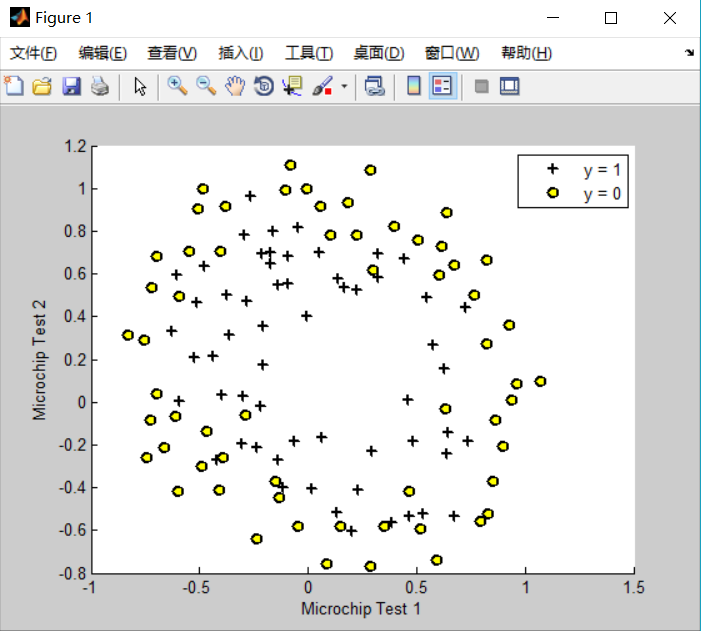
costFunction_Reg.m
1 function [J, grad] = costFunctionReg(theta, X, y, lambda) 2 %COSTFUNCTIONREG Compute cost and gradient for logistic regression with regularization 3 % J = COSTFUNCTIONREG(theta, X, y, lambda) computes the cost of using 4 % theta as the parameter for regularized logistic regression and the 5 % gradient of the cost w.r.t. to the parameters. 6 7 % Initialize some useful values 8 m = length(y); % number of training examples 9 10 % You need to return the following variables correctly 11 J = 0; 12 grad = zeros(size(theta)); 13 14 % ====================== YOUR CODE HERE ====================== 15 % Instructions: Compute the cost of a particular choice of theta. 16 % You should set J to the cost. 17 % Compute the partial derivatives and set grad to the partial 18 % derivatives of the cost w.r.t. each parameter in theta 19 alpha = 1; 20 other = lambda ./ (2 * m) * theta.^2 ; 21 J = (-1/m) * ( y' * log(sigmoid(X * theta)) + ( 1-y )'* log(1-sigmoid(X*theta))) + other ; 22 grad = ( alpha / m ) * X'* (sigmoid( X * theta ) - y) + lambda ./ m * theta ; 23 24 % ============================================================= 25 26 end





















 5154
5154











 被折叠的 条评论
为什么被折叠?
被折叠的 条评论
为什么被折叠?








